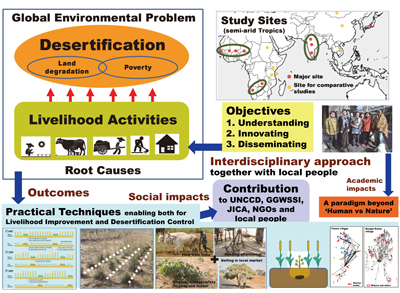Desertification and Livelihood in Semi-Arid Afro-Eurasia
Desertification is one of the major global environmental problems. International community ratified the United Nations Convention to Combat Desertification (UNCCD) in 1994. More than 20 years have passed since, but without sufficient achievement in this field. One of the principal reasons for the lack is that the root causes of desertification are local peoples’ daily livelihood and subsistence activities such as habitation, collection of fuel woods, animal husbandry and agriculture. Especially in the fragile environments of semi-arid Africa, local people have to combat desertification even as they remain reliant on the behaviors that are its cause.
In this context, we launched an interdisciplinary project focusing on desertification and livelihood as shown in Figure. The study sites were located in the semi-arid areas of West Africa, Southern Africa and South Asia, the so-called frontlines of desertification and poverty. The objectives and activities of our project were: 1) to deepen understanding of the areas experiencing desertification, examining its causes and local strategies of adaptation; 2) to innovate some practical techniques and approaches to control desertification; and 3) to disseminate project results and experiences.
Among the remarkable findings of our project was the determination that sand cover only a few centimeters thick affects the water and nutrient dynamics of sandy soils in semi-arid environments. This finding explains the rationality of the traditional ‘push-hoe’ widely used in the Sahel region of Africa encompassing between the Atlantic coasts of Senegal and the Red Sea of Sudan.
Together with local people and NGO members, project activity innovated some practical techniques. These include a ‘fallow-band system’ to prevent wind erosion and improve crop yield, use of ‘Andropogon (wild perennial grass) contour-lines’ to control water erosion and generate income, ‘shallow tillage with indigenous animal-driven plow from India’ to conserve soil moisture, ‘combination of fodder-type cowpea and indigenous Indian farming tools’ to convert degraded grassland into productive land, and a ‘modified agricultural extension method’ including some steps of a social network survey. To be practical, the techniques were designed to combine scientific knowledge and empirical local knowledge, to use local materials, and to reduce associated costs and labor. Each has the characteristic of being: 1) able to address livelihood improvement, desertification control, and ecosystem conservation/restoration concurrently; 2) easily implemented with particular consideration for the involvement of vulnerable people; and 3) disseminated directly by person-to-person communication. Our approach is therefore beyond the human vs nature dichotomy commonly found in desertification control, rural development support, and ecosystem conservation.
Our project received eighteen academic awards for its findings and innovations. These were given not only to us as researchers but also to local people who participated in the project with their empirical and indigenous knowledge. Some of our techniques have since been adopted by rural development projects in Africa. Our achievement was to develop practical innovations that also demonstrated the effectiveness of local knowledge and involvement. The end of the project is the beginning of our new challenge.
▲PAGE TOP
